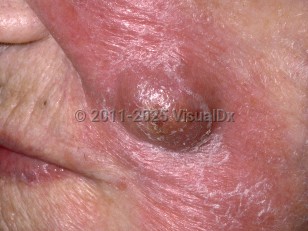Actinomyces israelii is the most common cause of actinomycosis. It normally colonizes oral, intestinal, and urogenital flora. The bacteria can become pathogenic following a breach of mucous membranes, often in the context of instrumentation (eg, dental procedures, gastrointestinal surgery, intrauterine device [IUD] placement). Infection leads to formation of granulomatous tissue, fibrosis, abscesses, sinus tracts, and fistulae.
Clinical presentations:
- Cervicofacial actinomycosis ("lumpy jaw") is the most common clinical form and typically arises following odontogenic infection or dental surgery. Infection can result from poor oral hygiene in patients with predisposing factors such as dental caries, gingivitis, oral trauma, and other oral infections. Infection over the mandible is more common than over the maxilla, and there may be associated periostitis or osteomyelitis.
- Pelvic actinomycosis typically arises in women with a history of prolonged IUD use and is the second most common form of actinomycosis after cervicofacial infection.
- Thoracic actinomycosis typically results from aspiration of secretions in patients with poor oral hygiene, alcohol use disorder, chronic lung disease, or preexisting dental disease.
- Abdominal actinomycosis most commonly affects the appendix, cecum, or colon following a mucosal breach from recent abdominal surgery or colonic perforation.



